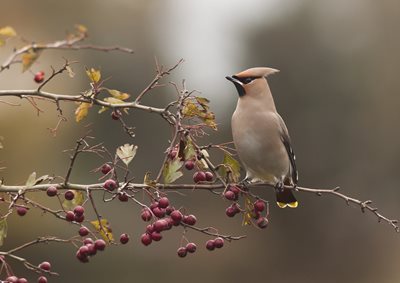We stalked along the lush verdant green, toadstools springing up at our feet. Streaked young blackbirds tore at the fruit of a holly bush, as pink-footed geese glided serenely overhead, honking as they flew. Before us stood a mighty oak, its leaves blushed orange in the absence of chlorophyll. Suddenly, a whir of wings made me turn my head, to see a large party of Scandinavian birds landing in the upper branches of the oak tree. As I focused my binoculars on an individual, its features became clear: a stocky, rosy peach body, spiky crest and coal-black eyepatch. The birds restlessly flitted from branch to branch, at the tips of their wings were small notches of white, yellow and crimson, like burnt wax.
From the group came a constant high trill, each call amalgamating with the next to form a recurring ringing. The birds were busy, not eating berries, but catching flies. Regularly they leapt from the trees to hover, then pluck an insect from the sky. This interesting behavior is more common on the Arctic pinewoods in which they breed, so a delight to see here. I quickly brought out my camera to photograph these hardy creatures, and for about an hour I just stayed to admire these wonderful waxwings!

Waxwing (c) Jamie Hall
These awesome birds (who in my books win first prize for best haircut) are rather rare in most years, but about every ten years many more migrate from northern Europe and Russia. 2023 is one of those years. From the start of October to mid-November, 1500 individuals appeared across the UK, a noticeable boom in numbers. Waxwings arrive on the east coast from Scotland to East Anglia at first, then move inland to gardens with hawthorn and rowan bushes.
They do this to take advantage of our winter berries, which grow sparse in the Arctic when the taiga is under a foot of ice and snow. From their wild northern habitats, waxwings tend to like supermarket car parks, which often contain roses and other fruiting trees. A particulalry large number have been seen around Norwich and in trees around Wiveton Common.
Waxwings are easily identifiable as essentially "peach-coloured Starlings with a crest". On their wings and tail are red, white and black markings. To fin them, you can listen out for the high trill they emit in flocks. So if you live in an urban area, with no shortage of fruiting bushes, look out for the cold-weather bird with a punk-rocker haircut!
Header image by Terry Whittaker